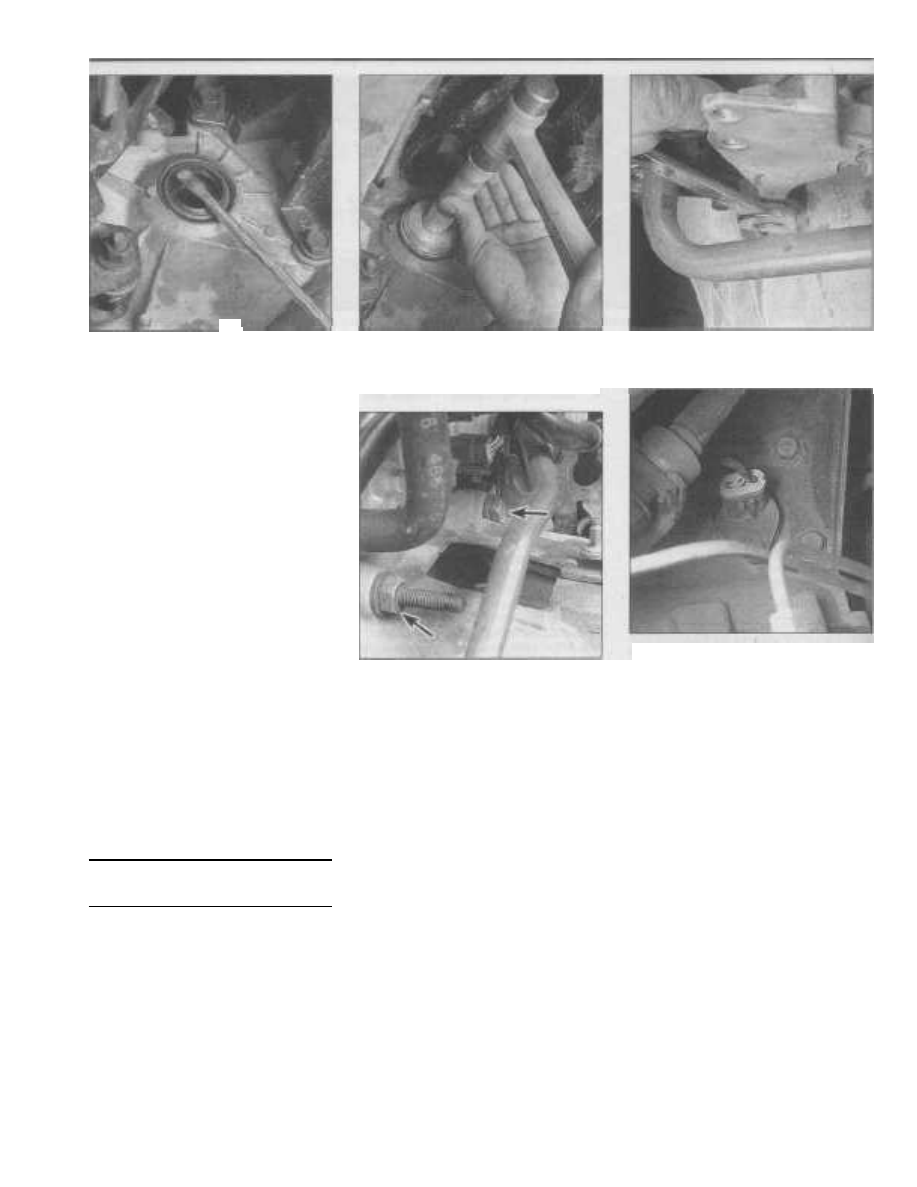Chrysler Cirrus, Dodge Stratus, Plymouth Breeze Haynes. Manual - part 24

7A-4
Chapter 7 Part A Manual transaxle
5.6 Using a seal driver, large section of
pipe or a large deep socket as a drift,
drive the new seal squarely into the bore
and make sure that it's completely seated
6.8 Remove the intake manifold
support bracket
6.9 Remove the upper clutch housing
fasteners (arrows)
6.10 The Vehicle Speed Sensor is located
on the transaxle next to the rear
engine mount
5.4 Using a large screwdriver or prybar,
carefully pry the oil seal out of the
transaxle (if you can't remove the oil seal
with a screwdriver or prybar, you may
need to obtain a special seal removal tool,
available at most auto parts stores, to do
the job)
inner ends of the driveaxles mate with the dif-
ferential side gears. If you suspect that one of
these seals is leaking, raise the vehicle and
support it securely on jackstands. If a seal is
in fact leaking, you'll see a trail of wet lubri-
cant on the side of the transaxle below the
seal.
3
Remove the driveaxle (see Chapter 8).
4
Using a large screwdriver or prybar,
carefully pry the oil seal out of the transaxle
(see illustration).
5
If you can't remove the oil seal with a
screwdriver or pry bar, you may need to
obtain a special seal removal tool (available
at most auto parts stores) to do the job.
6
Using a seal driver, large section of pipe
or a large deep socket as a drift, install the
new oil seal (see illustration). Drive it into the
bore squarely and make sure that it's com-
pletely seated. Lubricate the driveaxle oil
seal, tripod joint splines and sealing surface
with the appropriate transmission fluid (see
Chapter 1).
7
Install the driveaxle (see Chapter 8). Be
careful not to damage the lip of the new seal
during installation.
6
Manual transaxle - removal and
installation
Note 1: This procedure requires the removal
of all engine mounts except for the right side
engine mount. If the vehicle must be moved
after the transaxle has been removed, make
sure the engine is supported at all times and
the appropriate sized bolts and nuts are
installed in the front wheel hub/bearings (refer
to Chapter 8).
Note 2: There are four different gear ratios
available with this transaxle. If you are going
to replace this transaxle or obtain a rebuilt
unit, check the metal identification tag
mounted to the rear cover before purchasing
a new or rebuilt transaxle to ensure you're
getting the correct gear ratio for your particu-
lar application.
Removal
Refer to illustrations 6.8, 6.9, 6.10, 6.16, 6.17,
6.18, 6.19, 6.28 and 6.31
1
Open the hood and place protective
covers on the front fenders and cowl. Special
fender covers are available, but an old bed-
spread or blankets will also work.
2
Disconnect the negative battery cable
from the ground stud on the left shock tower
(see Chapter 5, Section 1).
3
Remove the air cleaner assembly (see
Chapter 4).
4
Disconnect the clutch cable from the
release lever (see Chapter 8).
5
Disconnect the shift cables from the
transaxle and detach the cable bracket (with
cables attached) from the transaxle (see Sec-
tion 2). Position the cables out of the way.
6
Detach the accelerator cable and cruise
control cable (if equipped) from the throttle
lever (see Chapter 4 if necessary).
7
Detach the accelerator/cruise control
cable bracket from the throttle body (with
cables attached) and position it out of the
way.
8
Remove the intake manifold support
bracket (see illustration).
9
Remove the upper clutch housing bolts
(see illustration).
10
Disconnect the electrical connectors
from the vehicle speed sensor (see illustra-
tion) and back-up light switch (see illustra-
tion 4.1).
11
Loosen the driveaxle hub nuts (see
Chapter 8) and front wheel lug nuts. Raise the
vehicle and place it securely on jackstands.
Remove both front wheels.
12
Drain the transaxle fluid (see Chapter 1).
13
Remove the driveaxles (see Chapter 8).
14
Remove the starter motor (see Chap-
ter 5).
15
Remove the splash shield/battery cover
from the left front wheel well (see Chapter 5).
Extract the push-in fasteners and remove the
transaxle splash shield.
16
On 1998 models, remove the oil pan-to-